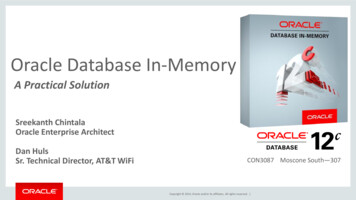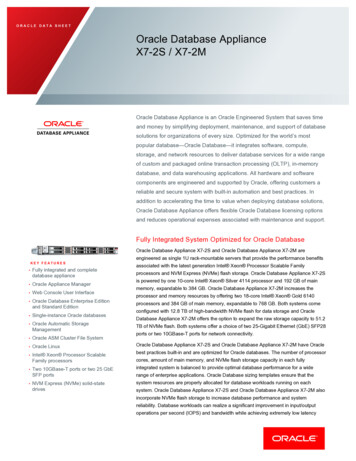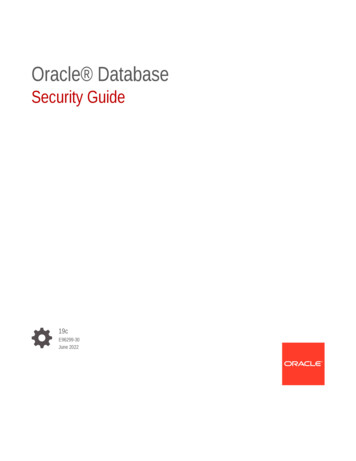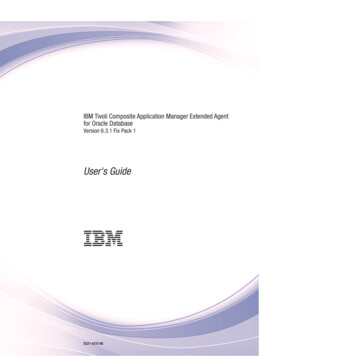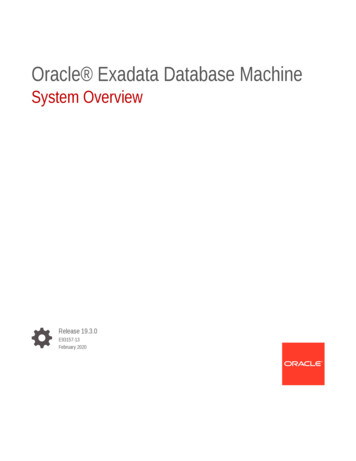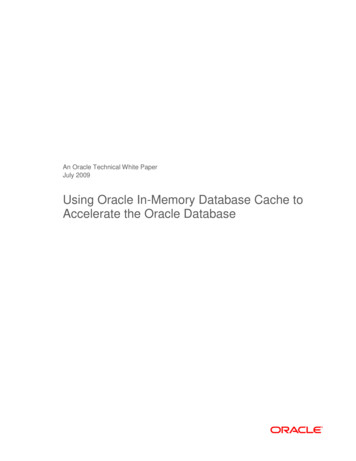
Transcription
An Oracle Technical White PaperJuly 2009Using Oracle In-Memory Database Cache toAccelerate the Oracle Database
Using Oracle In-Memory Database Cache to Accelerate the Oracle Database1. Introduction. 22. Application-Tier Caching. 43. The Oracle TimesTen In-Memory Database . 53.1 Oracle TimesTen Performance . 84. Data Caching Using Oracle In-Memory Database Cache . 84.1 Defining the Content of a Cache . 104.2 Loading Data and Managing the Cache. 114.3 Sharing Data Across a Cache Grid . 124.4 Maintaining Data Consistency . 134.5 High Availability . 185. Performance. 216. Examples. 236.1 Read-Only Cache . 236.2 Read-Only Sliding Window Cache . 246.3 Updatable Cache. 246.4 Updatable Dynamic Cache . 256.5 Data Capture Cache with Uneven Arrival Rate . 256.6 Data Capture Cache with Constant High Arrival Rate . 266.7 Updatable User-Managed Cache. 276.8 Read-Only Dynamic Distributed Cache. 277. Conclusion. 278. References . 28
Using Oracle In-Memory Database Cache to Accelerate the Oracle Database1. IntroductionThe Oracle In-Memory Database Cache accelerates business processes, enables real-time business intelligence, andfacilitates the personalization of customer-facing applications.The Oracle In-Memory Database Cache (IMDB Cache) is an Oracle Database productoption ideal for caching performance-critical subsets of an Oracle database in theapplication tier. Using the IMDB Cache improves an application’s response time andthroughput. The IMDB Cache consists of three key technology components – the OracleTimesTen In-Memory Database (TimesTen) for application-tier real-time datamanagement; caching technology to cache frequently-accessed tables from an OracleDatabase server to the application tier and maintain consistency of cached data; and atransactional data replication component to ensure cross-tier high availability.TimesTen is a memory-optimized relational database that delivers very low responsetime and very high throughput to performance-critical systems. It is targeted to run in theapplication tier, close to applications, and optionally in process with applications. ATimesTen database may be used as the database of record, and/or as a cache to anOracle database.Applications may create and manage database tables in TimesTen or cache frequentlyaccessed subsets of an Oracle Database in the IMDB Cache. Cached tables and noncached tables may coexist in the same in-memory database, and are all persistent andrecoverable. Queries and updates to cached and non-cached data are performed byapplications through SQL92 or PL/SQL using ODBC, JDBC, the Oracle Call Interface(OCI), or TTClasses, as well as Pro*C.Cache Grids are available for horizontal scalability in performance and capacity where aCache Grid consists of a collection of IMDB Caches that collectively manage anapplication’s cached data. Cached data is distributed between grid members, and theCache Grid provides applications with location transparency, effectively making theaggregate of data cached in all grid members available to the application. Cache Gridsenable incremental scalability through the online addition (and removal) of grid members.2
Using Oracle In-Memory Database Cache to Accelerate the Oracle DatabaseThey maintain consistency of cached data between the Cache Grid members and theOracle Database.The IMDB Cache manages the availability of data across the application tier and thedatabase server tier. It ensures high availability and no transaction loss no matter wherea failure may occur. Whether a failure occurs in one of the cache nodes, one of theOracle RAC nodes, at the network level or even for an entire RAC cluster, high avilabilityand no transaction loss are guaranteed.TimesTen and the IMDB Cache have a proven track record with production deploymentsin real-time enterprises and time-critical industries that include networktelecommunication services, operational support systems, contact centers, airline andreservation systems, command and control systems and securities trading. Hundreds ofcompanies worldwide use TimesTen and the IMDB Cache in production applications,including Alcatel-Lucent, Amdocs, Aspect, Avaya, Bombay Stock Exchange, BridgewaterSystems, BroadSoft, Cisco, Deutsche Börse, Ericsson, JP Morgan, NEC, NYFIX, SmartCommunications, and Sprint.3
Using Oracle In-Memory Database Cache to Accelerate the Oracle Database2. Application-Tier CachingApplication-tier caching is typically used to improve data access latency and to reduce workload on the back-end database.Various caching techniques have been developed to improve database access performance or toreduce contention on back-end database servers. Fast response time is particularly important forreal-time applications and customer-facing applications. In addition, reducing the workload onthe back-end database is important to applications with an ever-growing community of userssuch as hosted software services, eCommerce sites or telecommunication services.There are many choices as to what information to cache and where to cache it, with each optionoffering advantages and tradeoffs. Some of the caching techniques that have been developedinclude: Query results caches. This is typically done in the application tier and is managed by specialsoftware that hides the presence of the cache from the application. Under this scenario, thecaching software automatically saves the results of queries that are submitted to the databasesystem. A cache hit is recognized and serviced from the cache if a query is an identicalmatch to a previously-submitted query, including identical values of parameters. Theadvantage of such caching is that it is simple and it caters to access scenarios where the samequery is likely to be submitted over and over. However, it is limited in scope, as it cannothandle query processing on the content of the cache. Object-Relational mapping tool caches. Object-Relational mapping tools (O/R mapping tools)hide relational databases from object-oriented programmers by providing transparentmapping between objects and relational data. Once relational data is mapped to an objectrepresentation, it may be cached by the O/R mapping tool until it is no longer needed oruntil it becomes stale. Caching by O/R mapping tools is a common technique to avoid theexpensive mapping between the programming language’s object model and the database’srelational model. Object caches. The word caching is somewhat of a misnomer here because objects that end upin these caches are not necessarily subsets of objects that are stored elsewhere. These“caches” are repositories of objects that are independent of the objects’ origins. They arenot typically transparent to applications. Applications “put”, “get”, “insert” and “delete”objects from the caches. There are a few products on the market that offer such caches andthey vary in the level of functionality they support. The caches may be strictly memoryresident or they may be backed to disk, or to another data management system. Someproducts provide concurrency control, some provide transparent distribution over multiplenodes in a network, and some provide high availability.4
Using Oracle In-Memory Database Cache to Accelerate the Oracle DatabaseThe Oracle In-Memory Database Cache has full relational and SQL functionality, automatic maintenance of data consistencywith the Oracle Database and real-time performance .Oracle In-Memory Database Cache (IMDB Cache) takes a unique approach by enabling thecaching of tables or table fragments from an Oracle Database to the application tier. The tablefragments are described through an extended SQL syntax, and are cached into the OracleTimesTen In-Memory Database (TimesTen). Applications read and update cached data usingSQL, PL/SQL, or Pro*C and the IMDB Cache automatically propagates updates from theOracle Database to the cache and vice versa.A collection of IMDB Caches may be configured as a Cache Grid. Cached data is distributedbetween grid members, and the Cache Grid provides applications with location transparency andconcurrency control, effectively making the aggregate of all data cached in grid membersavailable to applications. As an application’s performance or capacity needs increase, additionalnodes may be added to the Cache Grid with no interruption to service. Thus, the IMDB Cacheoffers applications the full generality and functionality of a relational database, incrementalscalability coupled with location transparency, automatic maintenance of cache consistency withthe Oracle Database, and the real-time performance of an in-memory database.The IMDB Cache approach has two major benefits that contribute to improving overallperformance. First, applications that use the IMDB Cache experience significantly reducedresponse time and increased throughput due to the in-memory architecture of TimesTen and theelimination of communication between the application tier and the database server. Second, thisapproach reduces the workload on the back-end database thus improving overall throughput forall applications.The ability to provide all the advantages of relational databases, coupled with real-timeperformance, incremental scalability, and automatic cache management are unique to the IMDBCache. It is ideal for caching performance-critical subsets of an Oracle database, enabling bothreads and updates of cached data, and automatically managing data consistency.The next few sections will give a brief introduction to the Oracle TimesTen In-MemoryDatabase (more details may be found in [1]), a description of how data is cached and managed bythe Oracle In-Memory Database Cache, and a few illustrative caching scenarios.3. The Oracle TimesTen In-Memory DatabaseThe TimesTen In-Memory Database provides transactional access to data and relational functionality through standard APIs.The Oracle TimesTen In-Memory Database is a memory-optimized relational database thatsupports SQL92 and PL/SQL through the ODBC, JDBC, Oracle Call Interface (OCI), and5
Using Oracle In-Memory Database Cache to Accelerate the Oracle DatabaseTTClasses1 APIs, as well as through Pro*C/C . By supporting standard interfaces andpopular Oracle interfaces, TimesTen ensures ease of adoption by already-existing applications.Although TimesTen operates on data that is in main memory, TimesTen databases are persistentand recoverable in case of software, hardware or power failures. Durability is ensured throughcheckpointing and logging to disk. Applications may choose ACID properties for theirtransactions, but more relaxed options are also available for higher performance. TimesTenprovides a cost-based query optimizer and applications may view and influence query plans. TheTimesTen database is available as a library that may be linked by applications as well as through aclient/server option. When TimesTen is accessed through the client/server option, each requestto TimesTen incurs the overhead of inter-process communication even if the application and theTimesTen server are running on the same machine. By contrast, when TimesTen is linked withthe application, requests to TimesTen are nothing but local calls that incur a negligible overheadand any data transfers between the application and TimesTen are nothing but inexpensivememory copying operations. High availability is provided through replication. A number ofutilities are also available, including an interactive SQL utility, a graphical tool for databasedevelopment and cache configuration, on-line backup and restore, and bulk loading. Databasemaintenance operations are also available through programmatic APIs.A copy of the database resides in main memory at run time. It is managed in a shared memorysegment that is accessed by all processes connected to that database. Figure 1 shows thearchitecture of a TimesTen In-Memory Database system.The Oracle TimesTen In-Memory Database data structures and algorithms are optimized around the memory residence of data.TimesTen data structures and access algorithms exploit the memory residence of the database forbreakthrough performance. Compared to a fully cached disk-based database, TimesTen’smemory-optimized architecture uses far fewer CPU cycles, because the overhead to managememory buffers and account for multiple data locations (disk and memory) is eliminated.Oracle TimesTen’s memory-optimized performance is complemented by functionality thatsupports transactional properties, persistence mechanisms and recovery from system failures. Avariety of choices is available for locking, multi-user isolation and logging, accommodating aTimesTen C Interface Classes (TTClasses) is a C class library that provides wrappers aroundthe most common ODBC functionality. It is easier to use than ODBC and promotes best practiceswhile maintaining fast performance.16
Using Oracle In-Memory Database Cache to Accelerate the Oracle Databaserange of application scenarios from transient look-up caches to core transactional financialtrading and telecommunications billing systems.ApplicationroutinescodeTimesTenclient driverNetwork / Message BusReplication agent(s)Application ionroutinescodeIn-MemoryDatabasesTimesTenshared librariesDatabasebackgroundprocessesCheckpoint filesLog filesFigure 1. TimesTen ArchitectureTimesTen databases are persistent and recoverable.Durability is achieved in TimesTen by logging the changes from committed transactions to diskand periodically updating a disk image of the database through checkpoints. The timing of thedisk write for the log is configurable by the application, either synchronous with the end of thetransaction, or deferred until afterward, resulting in higher performance. Many situations favorhigher throughput over synchronous logging, particularly when the monetary value of atransaction is low or the transaction data is short-lived, such as when tracking the location ofmobile phones in a network which communicate their cell location every few seconds.TimesTen allows applications to track changes to specific tables. This is useful in environmentswhere applications are sensitive to the occurrence of certain events. For example, an applicationmay want to know when the price of a certain stock has risen above a given threshold. Thischange notification feature is particularly useful as it allows the tracking of changes not only tobase tables, but to materialized views as well.7
Using Oracle In-Memory Database Cache to Accelerate the Oracle Database3.1 Oracle TimesTen PerformanceVery low response times cannot be achieved through hardware additions. TimesTen delivers very low latency due to its uniquearchitecture.TimesTen can achieve response times in the microseconds due to its in-memory architecture.With TimesTen, a transaction that reads a database record can take fewer than 5 microseconds,and transactions that update or insert a record can take fewer than 15 microseconds.Average Response TimeTimesTen In-Memory ds40Update a recordRead a recordFigure 2. TimesTen Response TimeFigure 2 shows the response times for an application executing read and update transactions on a2-CPU Intel E5450 (8-way@3GHz) system running Oracle Enterprise Linux 5.2.4. Data Caching Using Oracle In-Memory Database CacheAn IMDB Cache contains subsets of an Oracle Database tables.The IMDB Cache enables the caching of subsets of tables from an Oracle Database to theapplication tier. Cached tables are updatable and the IMDB Cache synchronizes data betweenthe Oracle Database and the cache.The database engine that manages the cached data is the Oracle TimesTen In-Memory Database.It is augmented by the ability to load and synchronize cached data. One of the backgroundprocesses associated with the IMDB Cache is the Cache Agent, which manages some of thissynchronization. Figure 3 shows the architecture of an IMDB Cache.8
Using Oracle In-Memory Database Cache to Accelerate the Oracle DatabaseNetworkReplication agent(s)Application ionroutinescodeTimesTenshared librariesDatabasebackgroundprocessesCached TablesCheckpoint filesCache AgentLog filesFigure 3. IMDB Cache eStandbyActiveStandbyActiveFigure 4. Cache Grid with Five Replicated Grid Members9
Using Oracle In-Memory Database Cache to Accelerate the Oracle DatabaseA Cache Grid is a collection of IMDB Caches that collectively manage the application data. Acache grid consists of one or more grid members each backed by an IMDB Cache. Gridmembers cache tables from a central Oracle database or Real Application Cluster (RAC). Cacheddata is distributed across multiple nodes or IMDB Caches without shared storage. A Cache Gridensures that data is consistent across nodes. Grid members may be replicated.Figure 4 shows a Cache Grid consisting of five replicated grid members. Additional gridmembers may be added incrementally with no interruption to operations. The replicationconfiguration that must be used with the IMDB Cache is the active standby pair configuration.4.1 Defining the Content of a CacheThe content of an Oracle IMDB Cache is defined through an extended SQL syntax.A Cache Group is a set of IMDB Cache tables that corresponds to a set of frequently-used Oracledatabase tables that are related through foreign key constraints. SQL syntax is used to defineCache Groups and to choose the columns and rows that are to be cached from the Oracledatabase tables. Users may define Cache Groups programmatically or via the interactive ttIsqlutility.Example:Assume that the following tables exist in the Oracle Database:-Customer (CustId, Name, Age, Gender, StreetAddress, State, ZipCode, PhoneNo)Order (CustId, OrderId, PurchaseDate, Amount)CustInterest (CustId, Interest)An application may want to cache the profiles of customers who have placed orderssince January 1, 2009. To that end, it may define the following two cache groups: The first cache group contains subsets of the three tables above for customers whohave placed orders since January 1, 2009, and who also live in the Pacific region ofthe United States. Furthermore, the application may choose to cache only a subsetof the tables’ columns. For example, it may cache the following columns:- Customer (CustId, Name, Age, Gender, State)Order (CustId, PurchaseDate, Amount)CustInterest (CustId, Interest)The second cache group contains the same information as the first cache group, butfor customers in the Mountain region of the United States.The two cache groups may be cached on different nodes running IMDB Cache.10
Using Oracle In-Memory Database Cache to Accelerate the Oracle DatabaseAn additional concept used by the IMDB Cache is that of a Cache Instance. A Cache Instance is acollection of related records that are uniquely identifiable, and is used to model a complex object.Cache Instances form the unit of cache loading and cache aging as will be described below. Inthe example above, all records in the Customer, Order, and CustInterest tables that belong to agiven customer ID (CustId) belong to the same Cache Instance, and are related to each otherthrough foreign key constraints. CustId uniquely identifies the Cache Instance and is referred toas the Cache Instance Key.TimesTen supports the same data types as the Oracle Database.In addition to supporting its own data types, TimesTen supports the same basic data types as theOracle Database so there is no need to map Oracle Database data types to TimesTen data types.But it is possible to map Oracle Database data types to more efficient TimesTenimplementations. For example, an application may map an Oracle Database NUMBER datatype to a TimesTen INTEGER data type.Note that application developers can create indexes on the in-memory cache tables. The inmemory cache indexes may match the indexes in the Oracle Database or may be different. Theapplication designer can use the flexibility of TimesTen to create multiple indexes on the sametable and may define indexes over multiple columns.4.2 Loading Data and Managing the CacheAn application must decide how to load Cache Group data into the IMDB Cache for processing.The following techniques are available for loading data: Explicit Loading. This can be done in one of several ways:oLoad the entire Cache Group at once. This is a suitable technique to use if the contentof the entire Cache Group can fit in the cache. The ability to unload an entire CacheGroup is also available.oLoad Cache Instances “by WHERE clause”. In this case, a WHERE clause is used todescribe the subset of the Cache Instances that should be brought into the cache.Applications can also unload Cache Instances “by WHERE clause”.oLoad Cache Instances “by ID”. In this case, a list of Cache Instance Ids is used tospecify Cache Instances that should be brought into the cache. Applications can alsounload Cache Instances “by ID”.Dynamic Loading. This technique is available for loading cache instances. DynamicLoading is useful when the Cache Group is too large to fit in the cache, and hence only anapplication’s working set is to be kept in the cache. In this case, the records that make up a11
Using Oracle In-Memory Database Cache to Accelerate the Oracle DatabaseCache Instance are loaded into the cache automatically on a cache miss, i.e., when a SQLstatement2 does not find the requested data in the cache. If the Cache Instance is already inthe cache, the statement is handled directly from the cache.Dynamic Loading is typically coupled with automatic Cache Aging. Cache Instances can beautomatically aged out of the cache when the cache capacity is exceeded. IMDB Cachesupports Usage-Based Aging and Time-Based Aging. Usage-Based Aging uses an LRU (leastrecently used) scheme to age out Cache Instances when the cache capacity is exceeded.Time-Based Aging grants Cache Instances a Lifetime of a certain duration in the cache, andrequires the presence of a timestamp column in one of the tables of the Cache Group. Thevalue of the timestamp column is managed by the application. Cache Instances can remainin the cache as long as their timestamp value plus Lifetime does not exceed the current time.Note that Cache Aging can be used independently of dynamic loading, and in fact may beused with regular TimesTen tables that are not cached from an Oracle database.An application may choose to have some Cache Groups subject to aging and others not.For example, the application may want to keep catalog information in the cache at all times,but may want to load users’ profiles on demand when users connect to the application, andage out the profiles automatically when users disconnect. Cache Instances can also beexplicitly unloaded by the application.Data that has been loaded into in-memory cache tables is available for SQL, PL/SQL, Pro*Cprocessing through JDBC, ODBC, TTClasses, and OCI.4.3 Sharing Data Across a Cache GridCache Groups may be local or global. With Local Cache Groups, cached data is not shared acrossmembers of the same Cache Grid. Grid members may have disjoint data or overlapping data,and it is up to the application to determine how data is distributed among them. For exampleread-only catalog data may be cached in all grid members for best performance, and updatablecustomer information may be partitioned by geography in different grid members. Committedupdates on cached tables are propagated to Oracle tables with no coordination with other gridmembers. A Local Cache Group can be defined as explicitly loaded or dynamically loaded.Cache Groups are local by default, unless they are defined as global.Dynamic loading of a Cache Instance is available for SQL statements with an equality expression onthe primary key or foreign key of any of the records in the Cache Instance.212
Using Oracle In-Memory Database Cache to Accelerate the Oracle DatabaseIn a Global Cache Group, cached data is shared across members of the same Cache Grid.Concurrency control is enforced across the grid and a transaction running anywhere in the gridalways sees the most recent committed version of a Cache Instance. Committed updates to thesame Cache Instance by different grid members are propagated to the Oracle database in theorder in which they were committed within the grid to ensure data consistency.4.4 Maintaining Data ConsistencyThe Oracle IMDB Cache supports updates to cached data and automatically maintains consistencey between caches and theOracle Database.Cached data may be updated in the IMDB Cache or in the Oracle Database. The IMDB Cacheprovides the ability to automatically propagate updates from the cache to the Oracle Database,and vice versa. However, an underlying assumption is that a Cache Group is either mostly orexclusively updated in the cache, or in the Oracle Database. It is a major design flaw to cache aset of tables that are expected to be heavily updated in both the cache and the back-end database.There are, however, scenarios where it is appropriate to allow updates in both. The updates inthe Oracle database may, for example, occur only at night for maintenance reasons while updatestake place in the cache(s) during the day; or updates to central data may occur in the Oracledatabase, while updates to regional data occur in the cache(s).Cache Groups may be System-Managed or User-Managed. There are three types of System-ManagedCache Groups: Read-Only Cache Groups. These Cache Groups may not be updated in the cache. They maybe updated in the Oracle database, and the IMDB Cache manages the propagation ofupdates from the Oracle database to the cache. Asynchronous Writethrough (AWT) Cache Groups. These Cache Groups may be updated in thecache but not in the Oracle database. The IMDB Cache propagates updates from the cacheto the Oracle database asynchronously after the commit of a transaction. Synchronous Writethrough (SWT) Cache Groups. These Cache Groups may be updated in thecache but not in the Oracle database. Updates in the in-memory cache tables are propagatedto the Oracle database synchronously with the commit of a transaction.System-Managed Cache Groups have well-defined semantics and restrictions to enforce thesesemantics. By contrast, the semantics of User-Managed Cache Groups are left to the application.For example, a User-Managed Cache Group may be updatable in both the cache and the Oracledatabase.Read-only, AWT, SWT, and User-Managed Cache Groups may all be Local Cache Groups.However, only Dynamic AWT Cache Groups may be specified as Global Cache Groups.13
Using Oracle In-Memory Database Cache to Accelerate the Oracle DatabaseThe table below summarizes the various Cache Group loading, Cache Grid sharing, andconsistency maintenance options that are available.Maintaining DataConsistencyLoading data into a Cache GroupExplicit LoadingDynamic LoadingRead-OnlyCache GroupxxAWTCache GroupxxSWTCache GroupxxUser-ManagedCache GroupxxLocalCache GroupGlobalCache GroupLocalCache GroupxGlobalCache GroupSharing data across a Cache GridIMDB Cache applications can send SQL statements to either a Cache Group or to the OracleDatabase through a single connection to an IMDB Cache database. This single-connectioncapability is enabled by a PassThrough feature that checks if the SQL statement can be handledlocally by the in-memory cache tables or if it must be redirected to the Oracle Database. ThePassThrough feature provides settings that specify what types of statements are to be passedthrough and under what circumstances. One particularly useful setting is the one that specifiesthat all statements that update the database are to be passed to the Oracle Database. This settingallows an application to have updates executed in the Oracle Database and reads executed in theIMDB Cache through a single connection.The sections below describe the IMDB Cache operations available to maintain the consistency ofcached data. Some of these operations are initiated automatically by IMDB Cache; others areinitiated explicitly by the application.4.4.1 Update Propagation from IMDB Cache to Oracle Database and Among Cache GridMembers for Global Cache GroupsAs we have already seen, Global Cache Groups are also Dynamic AWT Cache Groups. Anapplication with Global Cache Groups will be connected to one of the grid members. Most ofthe time, it will access Cache Instances that are already cached in the grid member. However, incase it tries to access a Cache Instance that is not in the grid member, the IMDB Cache will loadthat Cache Instance dynamically either from another grid member of from the Oracle Database,depending on where the most recently updated version of the Cache Instance resides. This isdone automatically with no intervention from the application. The IMDB Cache determines14
TimesTen database may be used as the database of record, and/or as a cache to an Oracle database. Applications may create and manage database tables in TimesTen or cache frequently-accessed subsets of an Oracle Database in the IMDB Cache. Cached tables and non-cached tables may coexist in the same in-memory database, and are all persistent and

